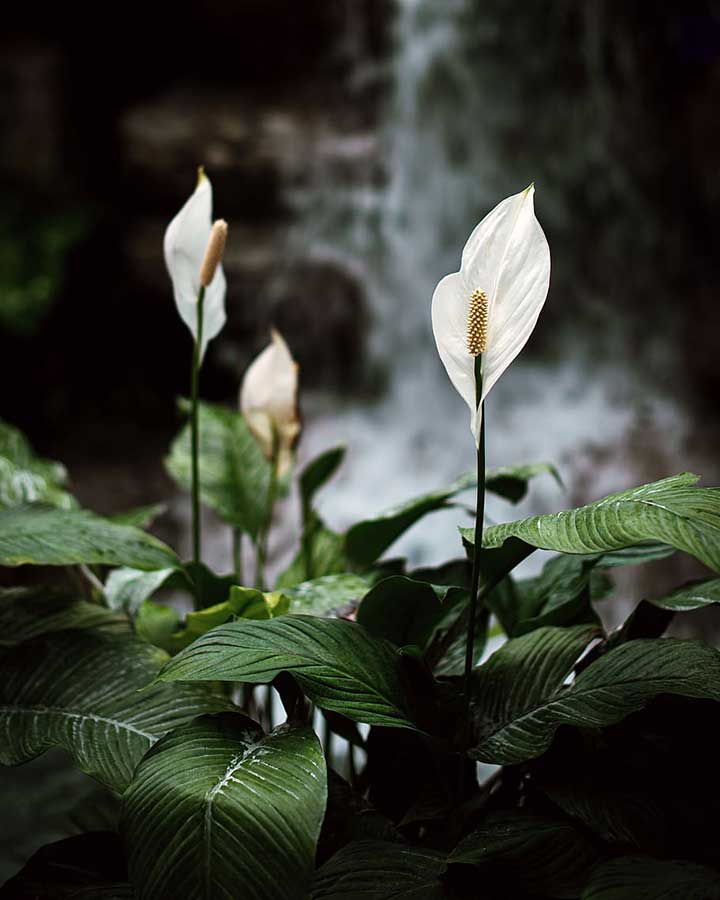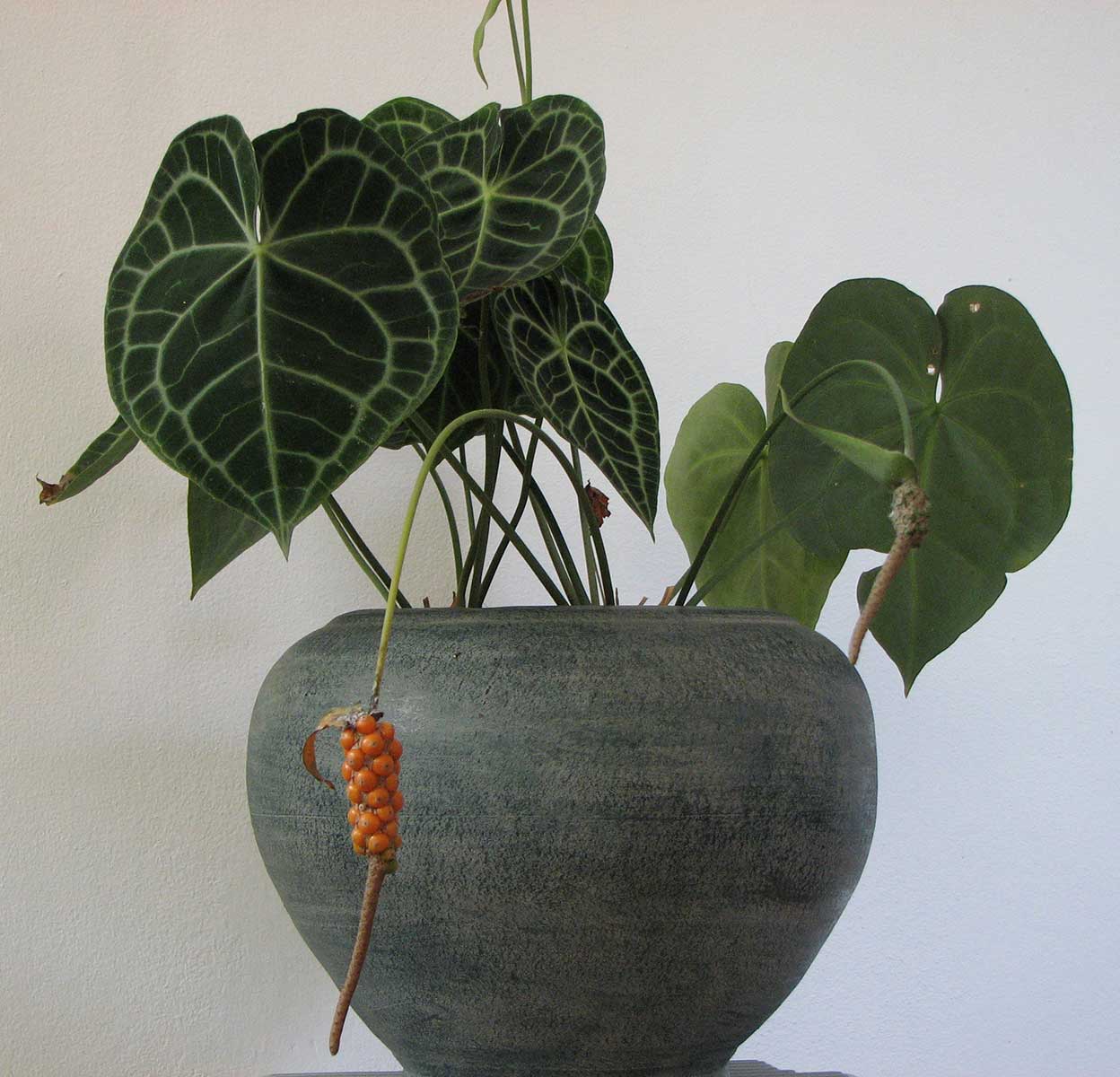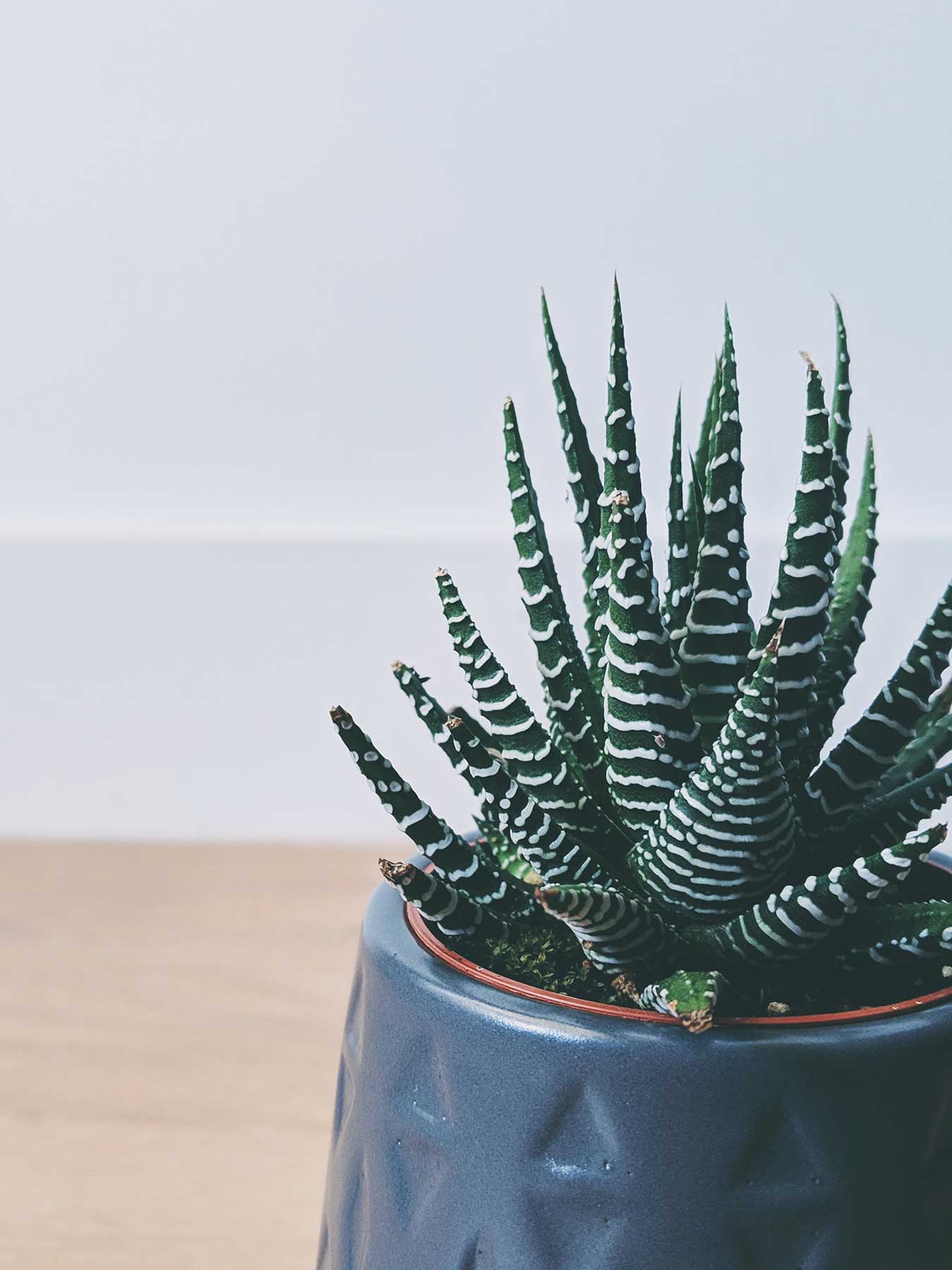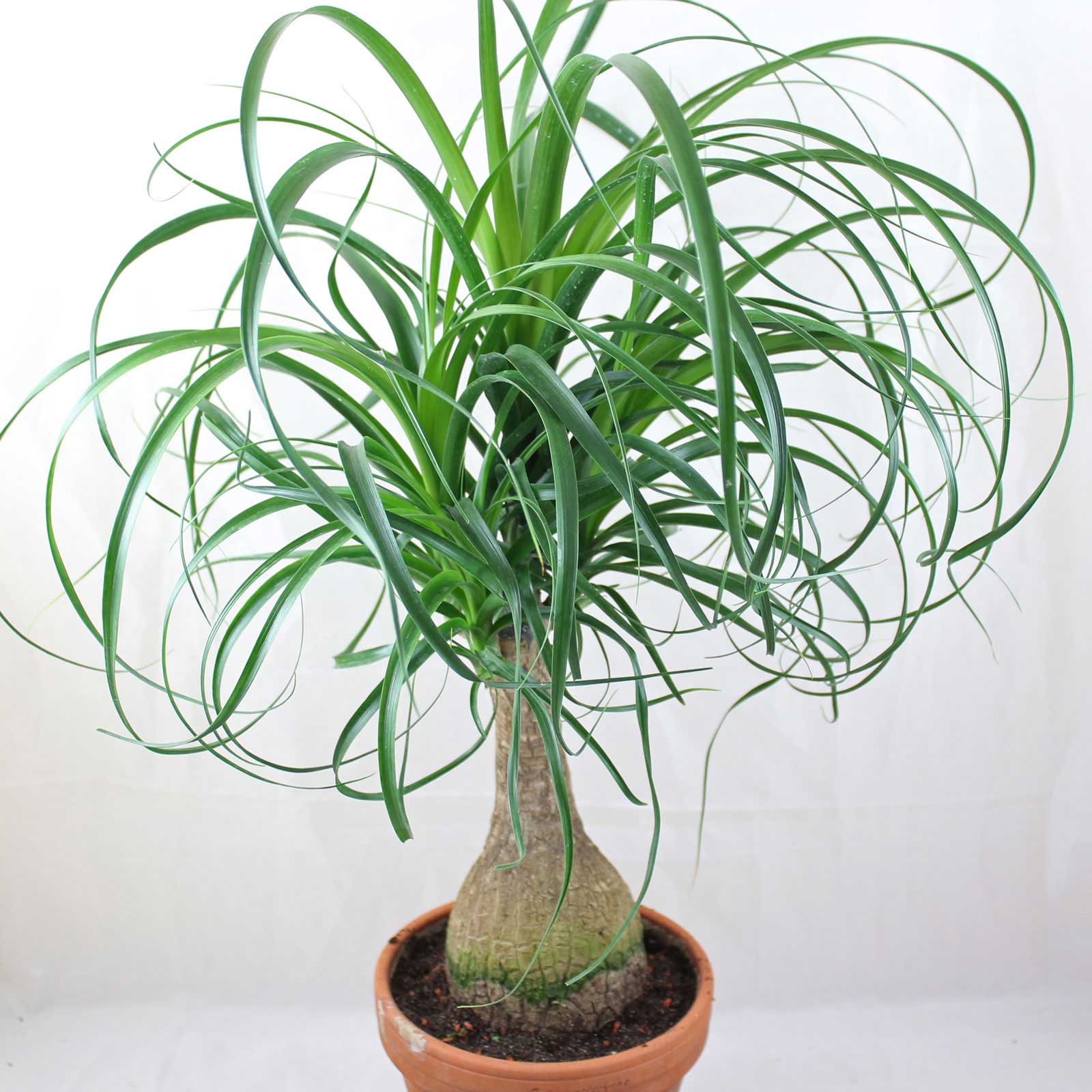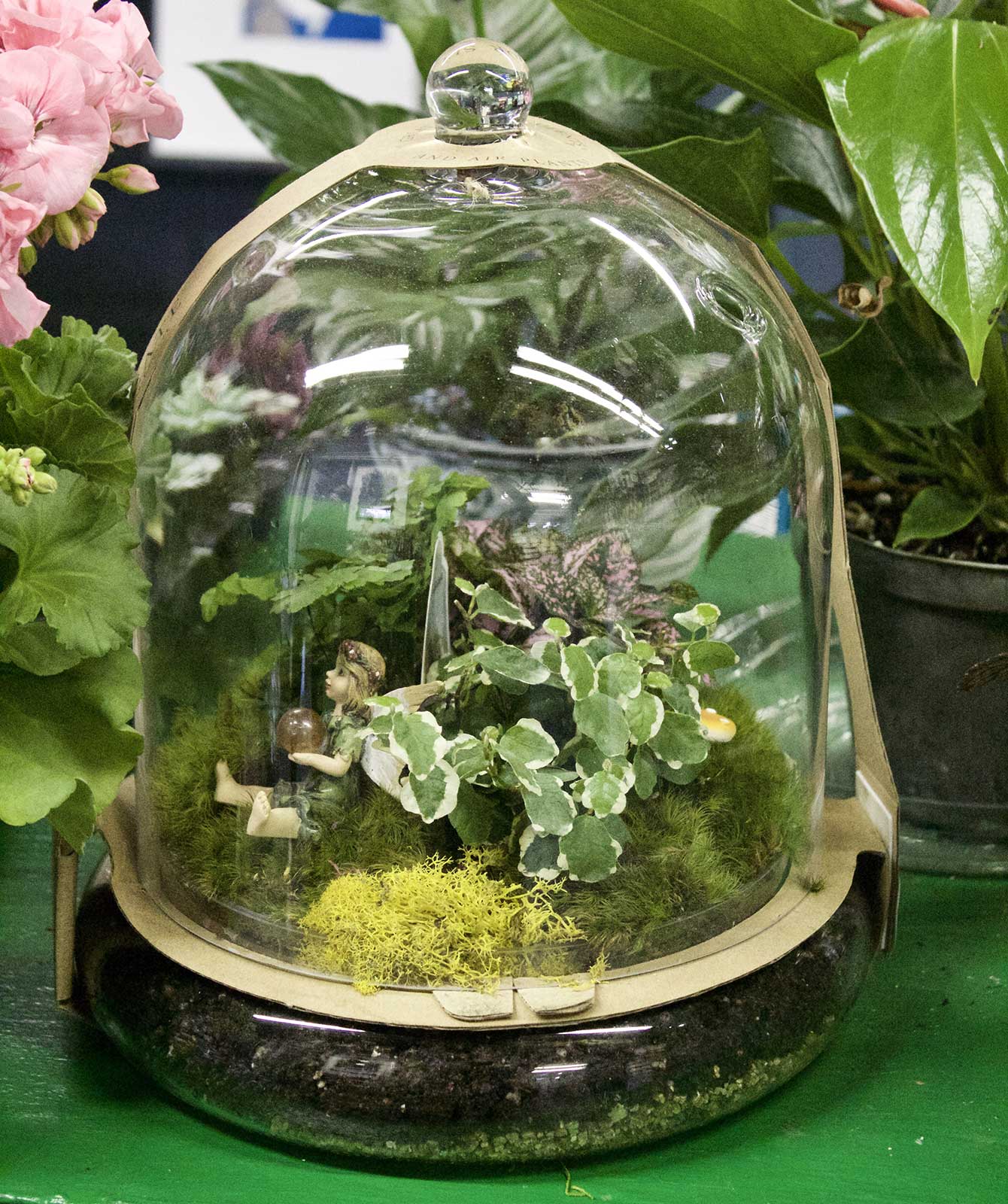Houseplants at Goffle Brook Farms
Houseplants bring life into a room and can even enhance mood. Those that flower bring color and sometimes even scent into your home. Foliage plants are available for all types of light conditions and can add a touch of green to any home or office. And, you’d be surprised how some can survive on the most minimal attention.
There have been several scientific studies into the health benefits of houseplants, and the results are pretty remarkable.
- Houseplants have been proven to improve air quality, raise humidity levels, and even help people to fight common illnesses. According to NASA, indoor plants can remove up to 87 percent of toxins from the air.
- Plants also release about 97% of the water they take in during photosynthesis, which increases humidity levels. This decreases the likeliness of getting a sore throat, cough, cold, and dry skin. By placing several plants close together, you can create an all-natural humidifier.
Whether your home has low light, indirect light, or a high light situation, we have a great selection of plants in all shapes and sizes with something for everyone including the young gardeners in your family. Plants are a great way to teach youngsters about mother nature and her wonders. We work really hard to keep new and interesting plants coming in on a regular basis, if you don’t see what you are looking for, just ask one our staff and we will do our best to locate it for you.
Our Indoor Plant Species
FOLIAGE PLANTS
Cultivated mainly for their lovely ornamental leaves which are particularly effective at catching the eye and purifying the atmosphere.
FLOWERING PLANTS
Add another touch of style to your living spaces, by adding color with exquisite blooms of unique and sometimes scented flowering houseplants.
SUCCULENTS
Easy to grow and require little maintenance. Succulents are water-retaining plants adapted to arid climate or soil conditions.
MINIATURES
Smaller varieties of the real thing. These plants are perfect for miniature gardens including: terrariums, dish gardens, hanging orbs, fairy gardens and more.
Croton
Dieffenbachia
Maidenhair fern
Moses In A Basket
Neanthe Bella Palm
Variegated Rubber Tree
Pothos
Foxtail Fern
Wandering Jew
Asparagus Fern
Terrarium Plants
Neon Joy Pothos
Fiscus
Gardenia
China Doll
Boston Fern
Snake Plant
Fiddle Leaf Fig
Shown below are a selection of some of our indoor houseplants. Our varieties and/or species changes seasonally and we are constantly getting new plants in throughout the year.
Anthurium
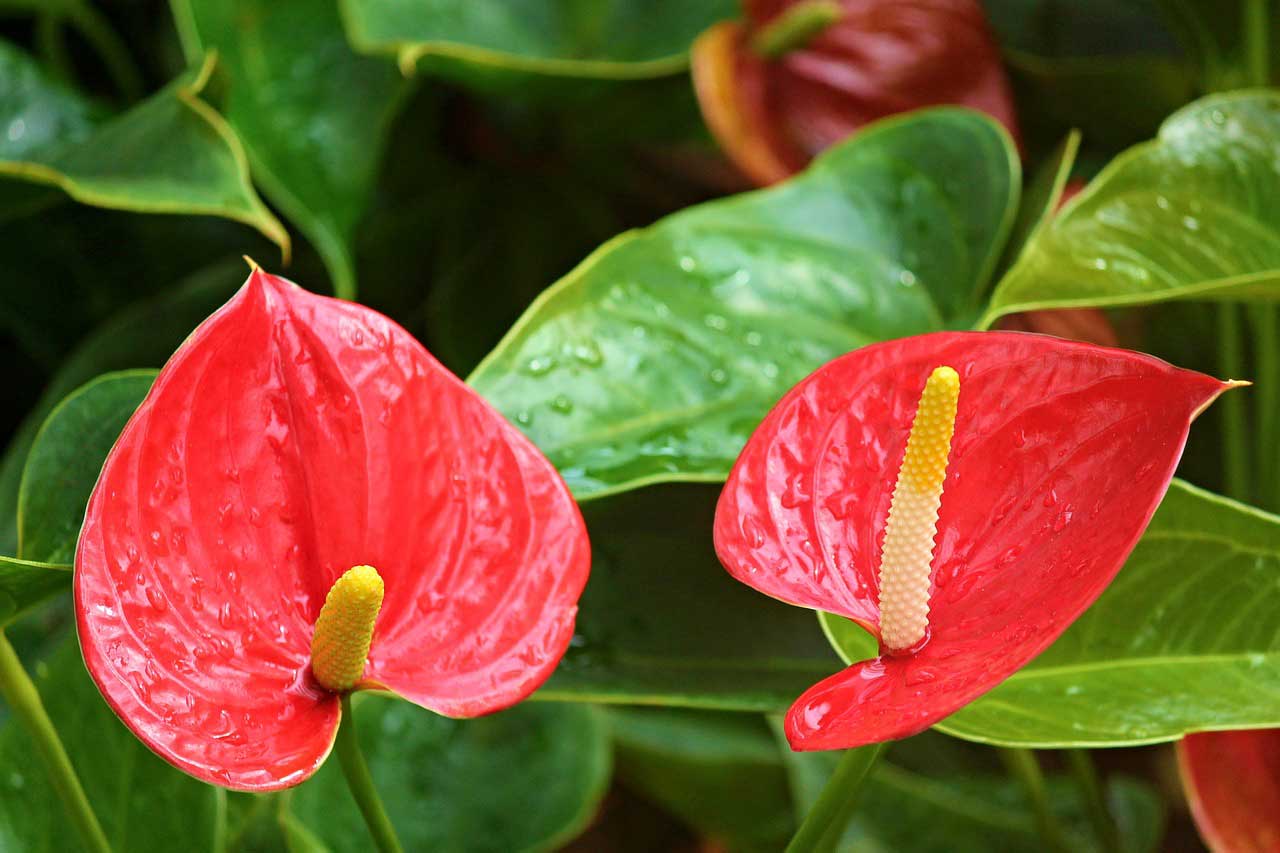
It is best to understand the natural environment of a plant in order to understand which plant care is best for your particular plant species. Anthurium is a rather large genus of evergreen perennials that are native to damp mountain forested areas or both subtropical and tropical North and South America.
As such humidity plays an important role in the plant’s health. Either lightly mist your anthurium every three or four days with lukewarm water or grow it in a setting with natural humidity like a kitchen or bathroom. Be careful though; it may like to be kept moist but do not get it soggy. That being said grow them in soil that is loose, humus, and well drained. Water the soil evenly and lightly.
Try to provide for it a constant temperature on the slightly warmer side and keep it away from air vents. As for light, try to give it bright yet filtered light. In other words don’t let the sun shine directly on it and avoid windows. Try placing them on a table near the window or perhaps a shelf where it will receive light in a diffused manner.
Every three to four weeks feed your anthuriums with a balanced fertilizer. They generally need repotted every three to four years. When the roots have basically taken over the soil content, repot the plant. Don’t let it get too root-bound. When repotting use a container “half again as big”, meaning if you are in a six inch pot now, then opt for a ten to twelve inch pot. An excellent growing medium for your indoor plants is Miracle Gro Potting Mix.
Miracle Gro All Purpose Plant Food and/or Miracle Gro Indoor Plant Spikes are an ideal solution to indoor plant feeding requirements. Both are safe for all houseplants when used as directed and the spikes feed plants for up to 2 months. They also contain micronutrients that are especially beneficial to houseplants. Both are available at the garden center.
Aloe Vera
An easy, attractive & tough indoor companion that likes bright, indirect light. Their leaves can also be used to relieve pain from scrapes and burns when applied topically. Beautiful & functional! A pot made from terra-cotta or a similarly porous material is recommended. All members of the Aloe genus require sandy or gravelly soil with very good drainage to reduce the risk of root rot and nutritional deficiencies. When planted in containers, aloe vera plants do well in a mixture of commercial potting mix with extra sand, granite grit or perlite added. They can also be planted in potting soil meant specifically for cactuses.
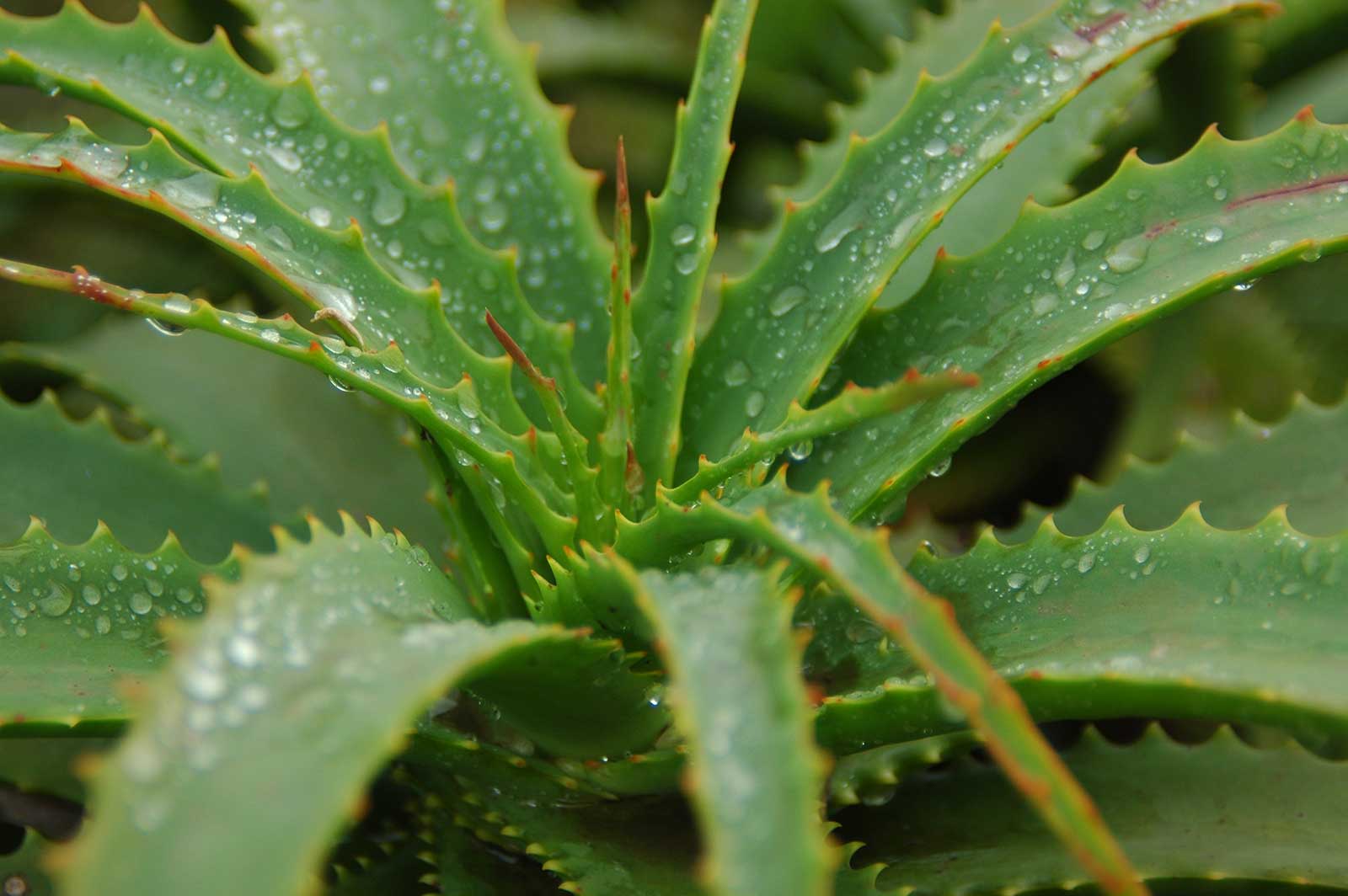
Prefers bright, indirect sunlight or artificial light in temperatures between 55 and 80°F. Water aloe vera plants deeply, but infrequently, about every three weeks. To make use of the aloe vera plant’s soothing properties, remove a mature leaf from the plant and cut it lengthwise. Squeeze the gel out of the leaf and apply it to your burn. Easily propagated with the removal of new offsets—also known as plantlets.
Grown at home, aloe vera can provide some tropical flair to your desktop or garden as an easy-going succulent. If you like, you can move your potted plant outdoors for the summer, but don’t put it in direct sunlight right away. Lace Aloe (Aloe aristata) shown to the right is petite sized with dark green leaves that reach up to four inches long. Aloe vera plants (Aloe vera or Aloe barbadensis) are originally native to arid parts of northern Africa.
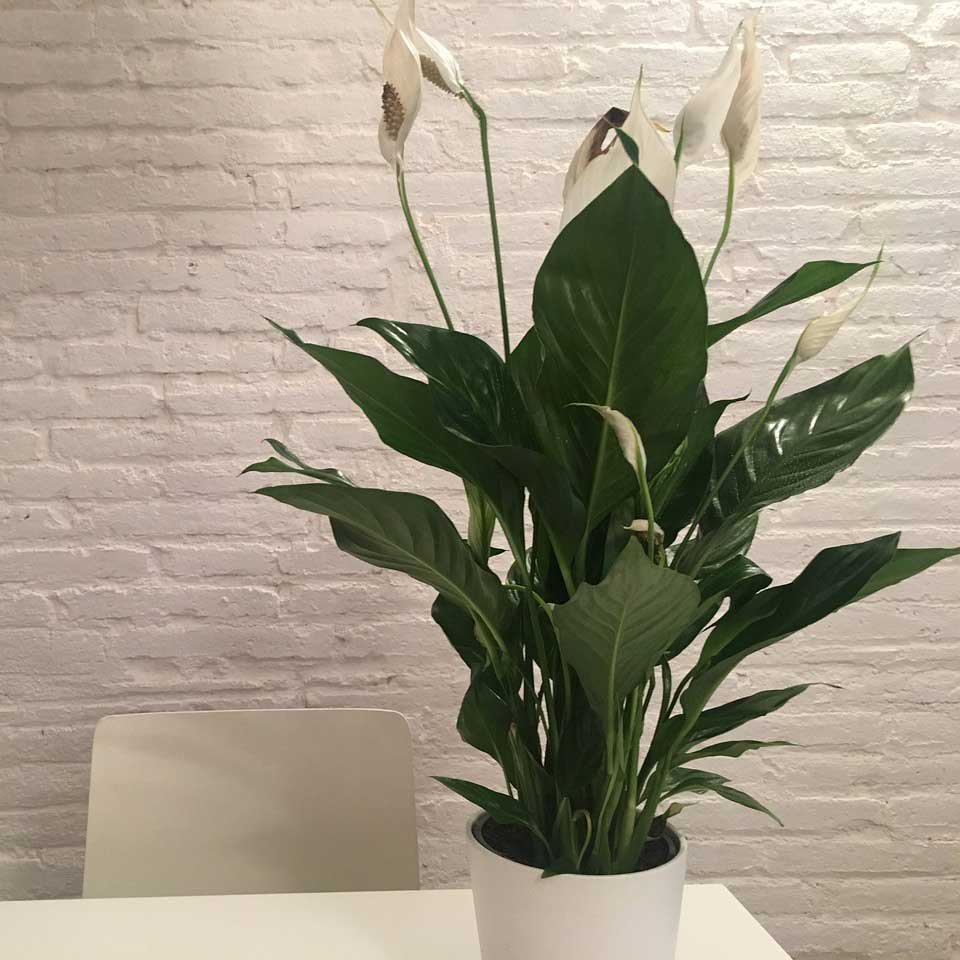
Spathiphyllum – Peace Lily
Peace lilies are indisputably terrific as houseplants. Small varieties look attractive on a tabletop and bigger ones can occupy a nice-sized spot on the floor. They filter more indoor pollutants than most other plants. A striking plant when used in mass display, the peace lily blooms in spring with long-lasting flowers that cascade gracefully over the leaves on the stalks. The plant has glossy oval leaves with an interesting vein structure.
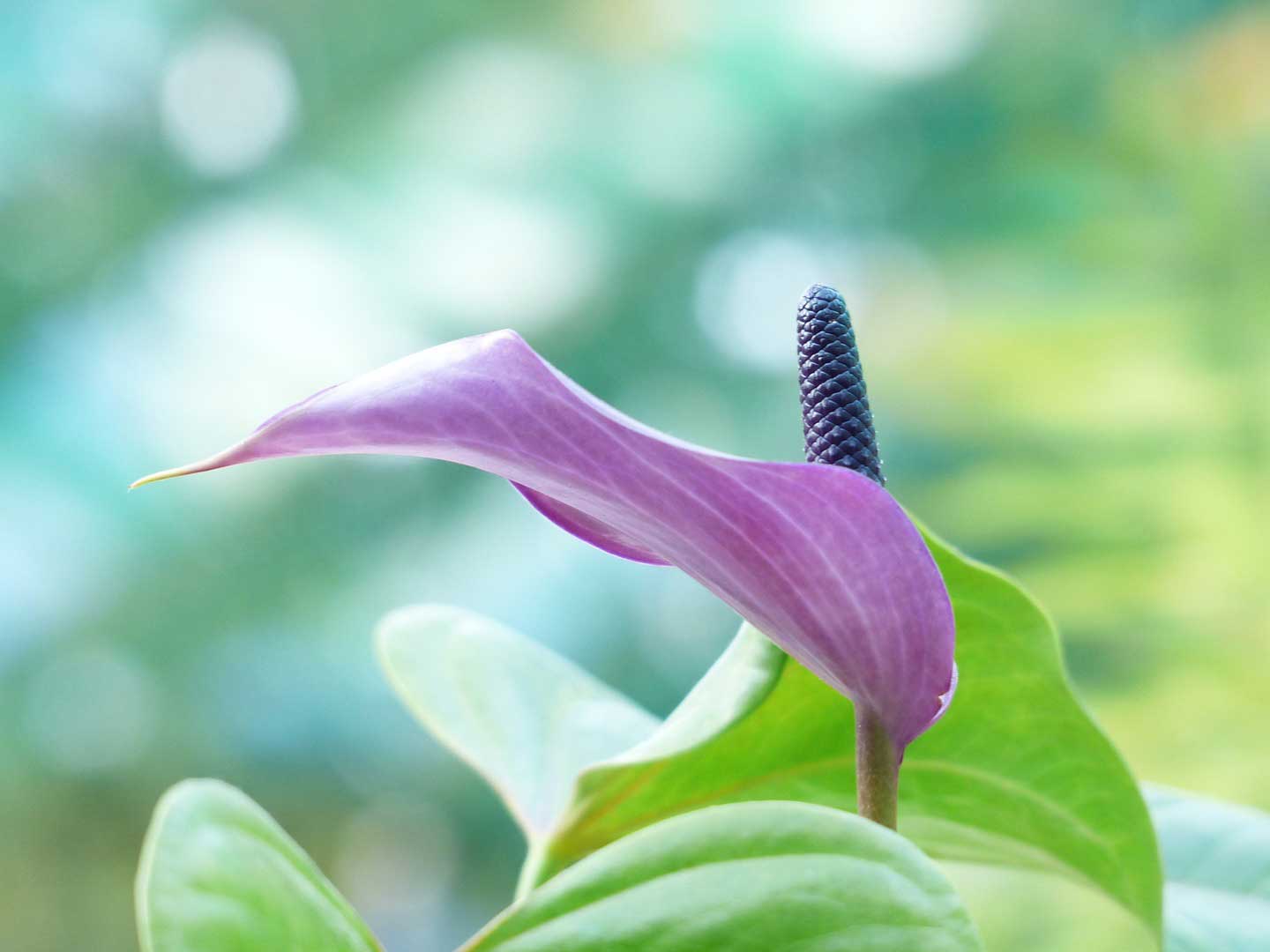
Despite their name, peace lilies are not members of the lily family. The peace lily is a member of the Araceae family of plants, known collectively as aroids. It is related to the philodendron, anthurium, and alocasia—also very popular as houseplants. The common name “peace lily” may come from the pure white flowers that look like white flags of surrender held above the plant.
These plants really prefer moist warmth. Avoid cold drafts and temperatures below 55 degrees F, since the plant will die with cold temperatures. Ideal temperature range is 65 to 80 degrees.
Peace Lily grows best in filtered indirect or diffused light. While Spathiphyllum will tolerate very low light, they are unlikely to bloom much, if at all. Curled, pale leaves generally indicate that the plant is receiving too much light and scorched leaves indicate too much direct sun. During the summer, water and mist peace lilies frequently because they thrive with higher humidity, such as that found in the rainforest. In winter, reduce watering but never allow the soil to dry out. If you grow your plant in a bright and warm place then these plants will be heavy drinkers (dark locations will mean low watering needs). Keep the soil moist, or wait until the plant starts to wilt a little. If your tap water is high in chlorine & salts, the leaves will show signs of burn. You may have to switch to filtered or distilled water
Peace Lilies (Spathiphyllum) do best if fertilized on a regular basis. To encourage spring and summer growth, fertilize every 6 weeks or so with a balanced houseplant fertilizer starting in late winter. Leaves with brown spots may be the result of over-fertilization. Peace lilies are best grown in large pots and generally should be kept somewhat root-bound. But when the plant has clearly exceeded the capacity of the pot, then it can be potted up to a larger container in the early spring.
Ponytail Palm
Ponytail palm tree has become a popular houseplant in recent years and it is easy to see why. Having a bulb-like trunk and lush, long curly leaves make it visually stunning; and the fact that a ponytail palm is forgiving and easy to care for makes this an ideal houseplant for many people. The common characteristics of this plant include a bulbous trunk, which is used to store water, and its long, hair-like leaves that grow from the top of the trunk like a ponytail, giving the plant its renowned name.
However a ponytail palm tree is neither a palm nor a tree. It is in fact a member of the Agave family which makes it a succulent. Some of the common names for this plant include bottle palm tree or elephant foot tree. Ponytail palms prefer bright light but if you keep it in low light conditions half the year and provide bright light conditions the other half the year, it will be perfectly happy. This means that as long as you place it outdoors in the summer, it will tolerate any indoor light conditions you keep it in during the winter.
Because ponytail palm care requires a dry soil growing medium, it is best to let them get root bound before repotting and when you do repot them, use a pot that is only an inch or two wider than the previous pot. If you repot them into a larger pot, they can get too much water at once, which can damage their growth and health.
A general guideline is to fertilize your plant once every 3 or 4 weeks. If you see the tips of the leaves start to turn brown, then you’re using too much fertilizer. Ponytail palm care is very easy and growing ponytail palms as a houseplant is a great way to add a stunning and visually interesting plant to almost any room and during the warmer months they provide excellent focal points and accent to outdoor living areas.
Mini-Gardens and Cloches
Create a mini-garden. Some are large and intricate, while others are simple. No matter how big or small, an indoor fairy garden can add some whimsical fun to your decor. Fairy Gardens are such a whimsical addition to any space, they spark imagination and creativity in both the child and adult. The idea of a fairy garden is that you add little plants, structures and flowers to create a magical place where fairies can come and bring good luck and blessings to your home.
Glass cloches create a perfect growing environment for a variety of plants, allowing moisture to recycle providing a consistent level of humidity. They need minimal care since the enclosed environment creates its own eco-system once established – so they do not need the typical watering a regular houseplant would require; just a tablespoon or two of water when the soil appears dry will suffice.
Cloches provide a constant level of humidity by allowing moisture to recycle. These hothouse conditions make them ideal for humidity-loving tropical plants that thrive in a moist, warm environment. Here are a few of the plants that will thrive under your bell jar:
- Maidenhair fern
- Creeping fig
- Baby tears
- Mini English ivy
- Philodendron
- African violet
- Orchid
Originating from France, cloches were traditionally used to protect fragile garden plants from being bitten by frost – but these beautiful bell jars (cloche is French for bell) were adopted by English plant enthusiasts in the late 1800s for decorative but practical use with indoor gardening. Many of our houseplants will thrive in these cloches and we have a diverse and unique selection of small garden decor to tastefully decorate your creation with a whimsical flair.
Indoor Plant Care Fertilizer
Miracle-Gro Indoor Plant Food Spikes
Miracle-Gro makes growing beautiful, vibrant houseplants easy with their Indoor Plant Food Spikes. Using the Miracle-Aerator spike, simply make a small hole in moist soil and insert the plant food spike. Then sit back, relax, and enjoy your happy houseplants.
In spring and summer, spikes should be replaced every 30 days, while in winter and fall wait 60 days before replacing them. Miracle-Gro Indoor Plant Food Spikes are ideal for feeding all indoor plants, including ficus, snake plant, croton, spider plants, and pothos.
Feeds all flowering and foliage houseplants. Feeds for up to 2 months.
Why Shop at Goffle Brook Farms
- Courteous, knowledgeable and professional staff
- Locally Grown Fresh Seasonal Produce
- Quality Perennials – Annuals – Herbs and Garden Plants
- Full-scale Garden Center on Premises
- Conveniently located in Ridgewood, New Jersey
- Open 7 days a week from March 15th through Christmas Eve
- Family owned and operated since May 1st, 1968
- Serving Bergen County for over FIFTY years
What Our Customer’s Say
Really cute garden center. My boyfriend and I stopped by to get some pumpkins. They had a great variety of both small and large pumpkins. They also have a small petting zoo with goats, sheep, and a pig. They have a small variety of produce for purchase inside. We wound up sampling cider they were selling and bought that as well as it was delicious. We may go back to get more. Employees were very helpful and friendly.
Highly recommend this garden center.
This is such a great place. Goffle Brook Farm & Garden Center has friendly and helpful staff that seem to really appreciate your business. They have a great selection of plants, flowers, gardening supplies, great FRESH local produce and I am sure tons of stuff I have yet to discover. The staff is very knowledgeable and always takes the time to walk me through any garden problem or question I have.
I’ve been going to Goffle Brook Farm & Garden Center regularly for the past year since my family moved to the area and every time I go I leave happy. What more can you ask for?They will have my loyal business. I think they deserve your business too.

